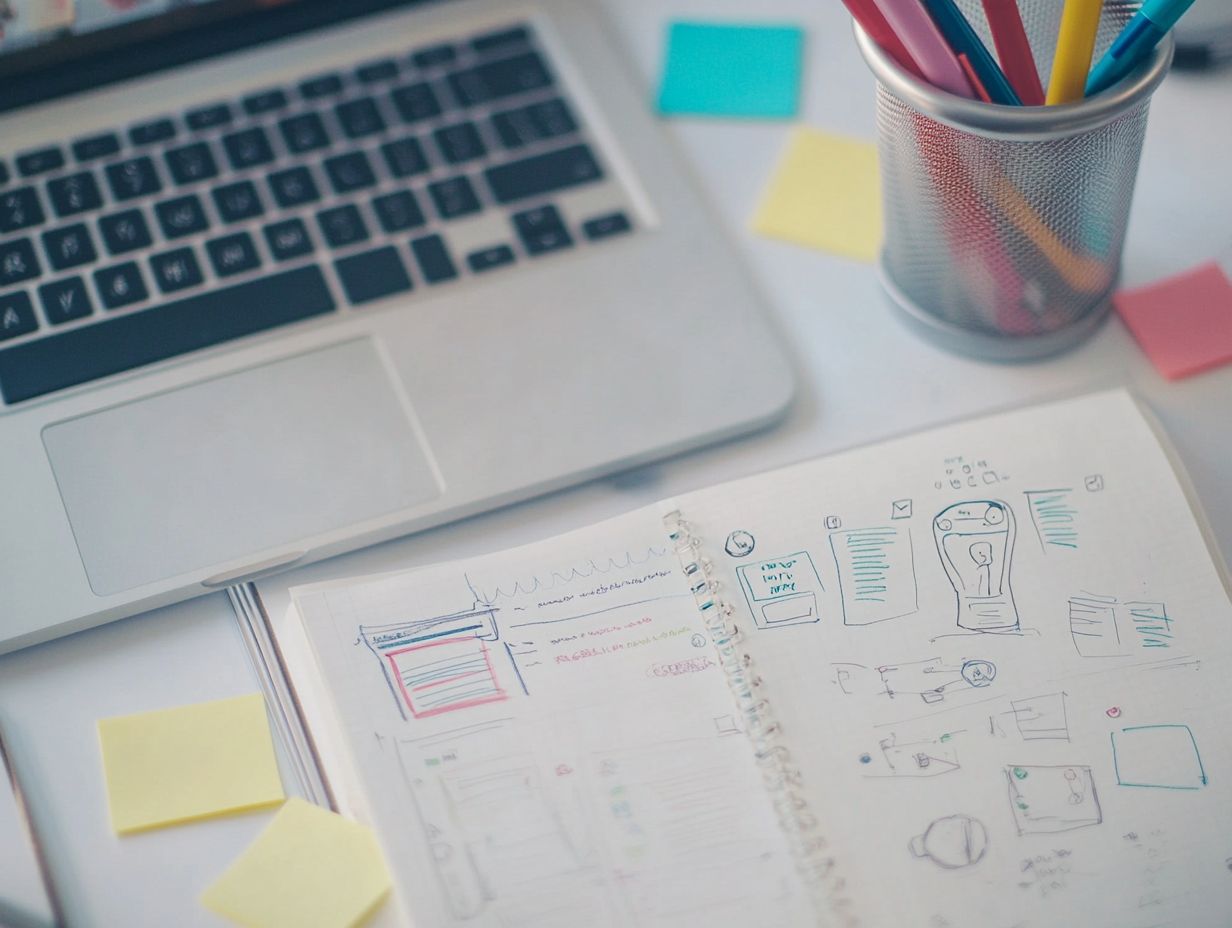How to Create Effective Design Diagrams
Creating effective design diagrams is essential for conveying detailed information with clarity and engagement. Whether you re working on a project for a client or streamlining your team s workflow, a thoughtfully crafted diagram can revolutionize your communication!
This guide walks you through critical steps, from understanding your audience to selecting the right tools, ensuring your diagrams resonate and communicate with impact. Discover how to simplify your design process and elevate your visual communication skills to new heights.
Contents
- Key Takeaways:
- 1. Understand the Purpose of the Design Diagram
- 2. Identify the Target Audience
- 3. Determine the Type of Design Diagram Needed
- 4. Gather All Necessary Information
- 5. Decide on a Layout and Format
- 6. Use Clear and Consistent Visuals
- 7. Label and Organize Elements Clearly
- 8. Use Appropriate Colors and Fonts
- 9. Include Supporting Information
- 10. Use Annotations and Callouts
- 11. Consider Accessibility and Inclusivity
- 12. Get Feedback and Make Revisions
- 13. Use the Right Tools and Software
- 14. Keep the Design Simple and Clean
- 15. Continuously Update and Improve the Design Diagram
- Frequently Asked Questions
- What are design diagrams and why are they important?
- What are the key elements to consider when creating effective design diagrams?
- How can I ensure that my design diagrams are easy to understand?
- What tools or software can I use to create effective design diagrams?
- Are there any best practices for organizing and presenting information in design diagrams?
- How can design diagrams be shared and used effectively in a team setting?
Key Takeaways:

- Know your diagram’s purpose to deliver your message effectively.
- Identify your target audience to tailor the design to their needs.
- Use clear visuals, labels, and organization to make your diagram easily understandable.
1. Understand the Purpose of the Design Diagram
Knowing the purpose of a design diagram is key. It helps bridge complex designs and clear visuals for stakeholders.
Define the diagram s objectives to choose visuals more intentionally. This allows you to select symbols, color schemes, and layouts that resonate specifically with your audience. Such deliberate choices not only enhance understanding but also engage stakeholders during discussions.
Effective communication through these diagrams enables stakeholders to quickly access vital information. This makes it easier for them to provide valuable feedback and input, leading to more productive collaborations. Ensuring everyone is aligned drives the project forward with greater efficiency.
2. Identify the Target Audience
Identifying your target audience is essential when designing visuals that effectively convey complex ideas. Their background knowledge significantly influences how you present information in design diagrams.
Understanding whether your audience comprises technical staff, stakeholders, or end-users is crucial for shaping your overall communication strategy. Technical personnel often appreciate intricate details, while stakeholders prefer straightforward, concise presentations that highlight significance without overwhelming them.
In contrast, end-users typically benefit from visuals that simplify concepts and emphasize practical applications. By tailoring the complexity of your visuals to align with the audience’s expertise and needs, you enhance understanding and engagement, ultimately leading to more effective communication.
3. Determine the Type of Design Diagram Needed
Choosing the right design diagram whether it s a component diagram, container diagram, or flowchart ensures you convey your intended message with clarity. This allows stakeholders to visualize the system architecture effectively.
Each type of diagram serves a distinct purpose in the technical design landscape. For instance, component diagrams showcase the various parts of a system and their interrelationships, making them ideal for grasping a system s modular structure. Container diagrams offer a comprehensive view of data storage and execution environments, essential for devising deployment strategies. Flowcharts simplify complex processes into clear, sequential steps, paving the way for straightforward communication among team members.
By leveraging the appropriate diagrams, you enhance clarity and streamline discussions, ultimately leading to a more efficient and productive development process.
4. Gather All Necessary Information
Gathering all necessary information is the essential first step in creating effective design diagrams. This process not only enhances information retrieval but also ensures that your technical designs are accurately represented to stakeholders.
You’ll often find that conducting stakeholder interviews is invaluable. It allows you to gather insights and perspectives directly from those involved, fostering clarity around project objectives and requirements. Reviewing existing documentation reveals crucial background information that informs your design choices.
By combining these approaches, you can develop a comprehensive understanding of the project’s scope, enabling you to craft diagrams that fulfill functional needs and align seamlessly with stakeholder expectations.
Ultimately, thorough data collection sets the stage for more precise and communicative visual representations.
5. Decide on a Layout and Format

Choosing the perfect layout and format can make your design diagrams shine! It directly affects their readability and overall impact.
A well-organized diagram allows viewers to grasp complex information at a glance, making it much easier for them to understand.
When deciding between a simple design or interactive visuals, remember that this choice can significantly influence how stakeholders engage with your material. Simple designs bring clarity through structured information, ideal for those seeking straightforward insights. On the other hand, interactive visuals can capture interest and encourage deeper exploration of the content.
Each option has unique advantages in terms of legibility and engagement. Therefore, it s essential to consider your audience’s needs and preferences before making a decision.
6. Use Clear and Consistent Visuals
Using clear and consistent visuals in your design diagrams is essential for enhancing understanding. This approach helps cultivate a clear communication style that truly resonates with your target audience.
When you use diagram templates and shape tools, you can significantly elevate both the organization and presentation of your ideas. These tools enable you to create a structured framework that enhances clarity and ensures consistency across various materials. Research shows that the human brain processes visuals far more swiftly than text, leading to improved information retention.
Well-crafted visuals can provoke emotional responses and simplify complex concepts, making them more digestible. By incorporating these elements into your designs, you can foster deeper engagement and create a lasting impact.
7. Label and Organize Elements Clearly
Clear labeling and organization of elements within your design diagrams significantly enhance legibility. This ensures that stakeholders can swiftly understand the relationships between different components.
Strategically placing and hierarchically structuring labels allows viewers to navigate the diagram effortlessly. Utilizing variations in font size and weight emphasizes the most critical elements, guiding the audience’s attention to essential information first.
Consistently aligning labels whether left, right, or centered creates a clean visual flow that enhances understanding. By following these best practices, you transform your diagram from a simple illustration into a powerful communication tool. This fosters engagement and supports collaborative discussions.
This approach not only boosts comprehension but also facilitates better decision-making processes.
8. Use Appropriate Colors and Fonts
Choosing the right colors and fonts can greatly improve your design diagrams. These elements boost readability and set the emotional tone for the information.
Select hues that resonate with your audience to evoke feelings and create a meaningful connection. The right typography can express professionalism or creativity, depending on your message.
When your design choices align with your audience’s expectations, they encourage engagement and create a favorable reception.
The combination of color and typography enhances comprehension and strengthens your brand identity. This makes your diagram more memorable and impactful.
9. Include Supporting Information
Adding supporting information like annotations and callouts elevates your design diagrams. These elements provide context and insights into complex designs.
Thoughtfully incorporating them guides viewers through intricate processes, making every component clear. Annotations clarify purposes, while callouts highlight critical issues for easy understanding.
Annotations do more than supplement your content; they connect gaps in understanding, fostering coherent discussions around the design.
10. Use Annotations and Callouts

Annotations and callouts are powerful tools in your design diagrams. They help communicate specific details that might not be immediately evident.
Positioning these elements strategically creates a more interactive experience. This approach clarifies complex information and guides stakeholders through key insights.
Well-placed annotations make your narrative more accessible. This allows diverse audiences to navigate the material effortlessly while keeping their interest alive.
Ultimately, this technique creates a more collaborative atmosphere where feedback and dialogue can thrive.
11. Consider Accessibility and Inclusivity
It’s crucial to prioritize accessibility and inclusivity in your design diagrams. Doing so ensures that every stakeholder can engage and understand the information.
Focus on high color contrast so vital information stands out. Use legible fonts for better understanding; sans-serif fonts are often clearer.
Including alternative text descriptions for visuals is essential. This allows individuals using screen readers to grasp the content effectively.
Engaging a diverse group during the design process provides valuable insights into accessibility needs, enriching your designs.
12. Get Feedback and Make Revisions
Getting feedback and making revisions is key to your design process. This helps refine your diagrams to meet stakeholders’ needs and improve communication.
This approach creates a collaborative atmosphere. Engaging stakeholders at different stages allows you to gather diverse perspectives, revealing areas for improvement.
13. Use the Right Tools and Software
Using the right tools like Miro or Lucidchart can boost the quality and efficiency of your diagrams. These platforms make it easier to convey complex ideas visually.
Miro allows you to create interactive boards for everything from mind maps to flowcharts. Lucidchart offers a user-friendly interface and a rich library of shapes, ensuring clarity in complex data.
14. Keep the Design Simple and Clean
Keeping your design simple and clean is crucial for effective communication. Cluttered visuals can confuse stakeholders and distract from your core message.
A sleek design enhances readability and directs focus to critical information. Use ample white space, clear typography, and a limited color palette for a user-friendly experience.
15. Continuously Update and Improve the Design Diagram

Regularly updating your design diagrams keeps them relevant as technical designs and stakeholder needs evolve. This involves ongoing assessments to ensure alignment with current requirements.
Engaging stakeholders helps uncover insights for necessary adjustments. These improvements enhance communication and understanding among team members.
Frequently Asked Questions
Wondering what design diagrams are? Here s a quick overview:
What are design diagrams and why are they important?
Design diagrams are graphical representations of a system or process that illustrate how it works. They are important because they help communicate complex ideas and concepts in a visual and easy-to-understand format.
What are the key elements to consider when creating effective design diagrams?
The key elements are clarity, simplicity, consistency, and accuracy. These aspects ensure your diagram is easy to understand and visually appealing.
How can I ensure that my design diagrams are easy to understand?
Use clear labels and visual markers. Including a legend can help explain any complex symbols.
What tools or software can I use to create effective design diagrams?
Check out tools like Microsoft Visio, Lucidchart, and Draw.io. You can even start with just a pencil and paper!
Are there any best practices for organizing and presenting information in design diagrams?
Yes! Follow a logical flow and group related elements together. Use colors and shapes thoughtfully to represent different components.
Share diagrams using collaborative tools like Google Docs or Mural. Clear discussions around the diagram will ensure everyone understands its purpose.






